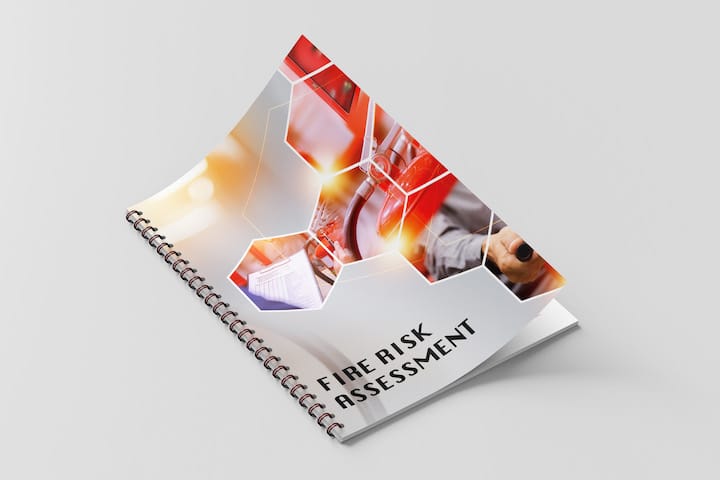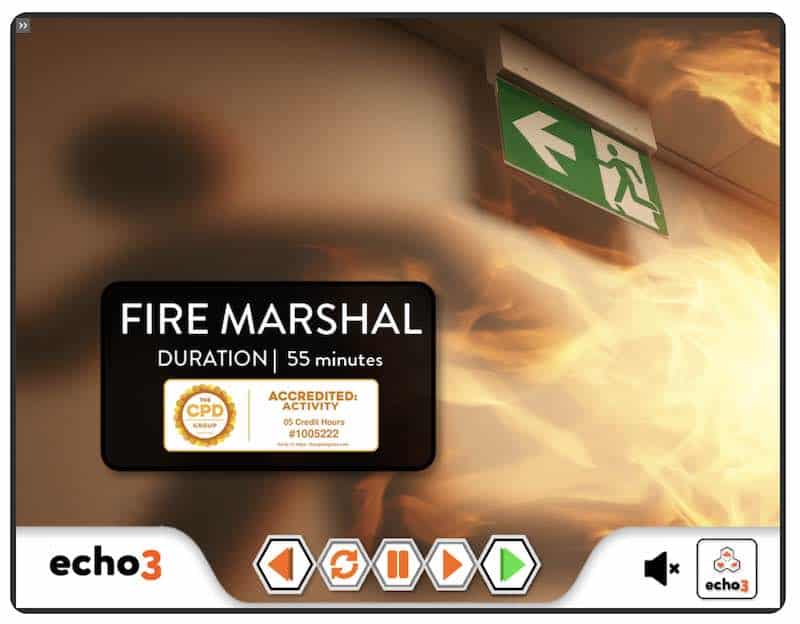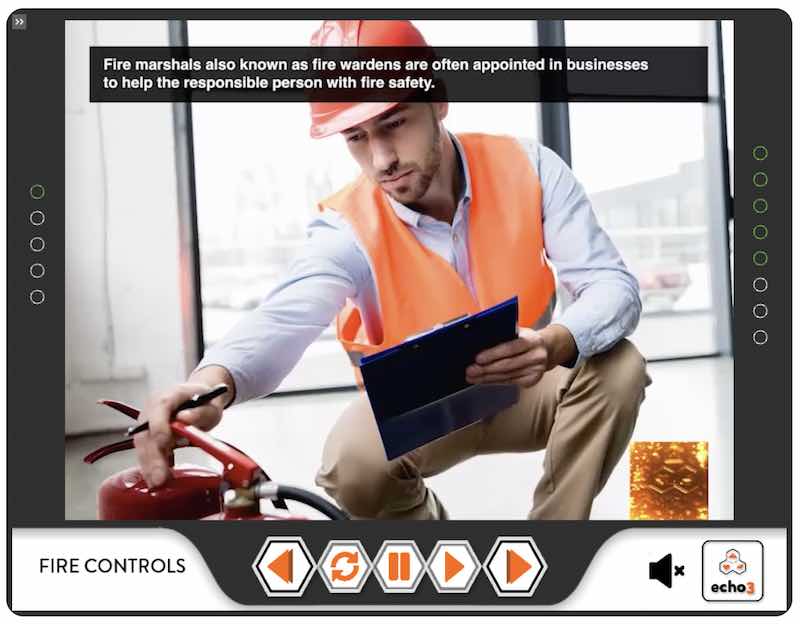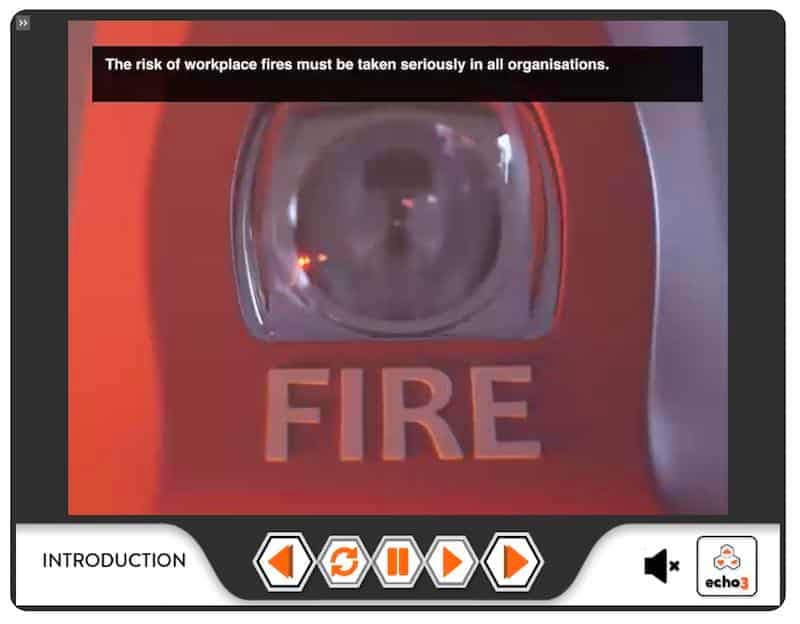Your basket is currently empty!

Fire Marshal Course
Online Fire Marshal course for everyone with fire marshal or fire warden duties. The training provides the knowledge needed to work safely and helps compliance to fire safety regulations.
- For Me
- For Teams
FIRE MARSHAL COURSE
Each year across the UK there are around 20,000 workplace fires. Many of these fires can be prevented with properly trained staff.
This online Fire Marshal course provides essential for all those how understand the duties of a fire marshal.
Appropriate training is a requirement of fire safety regulations. Everyone working as a fire marshal should be aware of best practices for both preventing and mitigating fires.
FIRE MARSHAL CERTIFICATE
At the end of the online Fire Marshal training there is a, multiple-choice assessment. If learners demonstrate their understanding of course content by achieving a minimum score of 80%, we’ll email the completion certificate.
If learners score less than 80%, they can revisit any part of the course and retake the quiz until they are successful. A posted certificate is available for £9.
The Fire Marshal certificate is valid for 3 years.

COURSE CONTENT
UNIT 1 | REGULATIONS
Firstly, we outline the legal landscape, including differences between the home nations. We also highlight the specific duties upon both employers and employees.
UNIT 2 | HOW FIRES START AND WHY
In UNIT 2 we explore how a fire starts and is sustained. This information is important in understanding how to prevent fires from starting in the first place, as well as what can be done in the unlikely event that you have to tackle a fire.
UNIT 3 | FIRE PREVENTION
It is vital that a pro-active approach to fire safety is taken to minimise the likelihood of a fire starting in the first place. An essential component of fire prevention is identifying and assessing any potential risks and putting measures in place to reduce these risks. This Unit looks at fire risk assessments in more detail.
UNIT 4 | FIRE MARSHALS & THEIR EMERGENCY RESPONSE
In addition to day-to-day fire prevention duties, fire marshals have the potentially life-saving responsibility to oversee emergency response in the case of a fire breaking out. In this unit we look at general emergency evacuation procedures, as well as identifying specific Fire Marshal duties.
UNIT 5 | IF, WHEN AND HOW TO FIGHT A FIRE
In this UNIT, we look at the information you need for fighting fires. But please remember, you should only fight fires if you’ve been trained to do so, and if the fire is still in the early stages.
UNIT 6 | EMERGENCY FIRST AID
It is useful for Fire Marshals to know how to treat a minor burn, so this is the focus of this final short unit. Your organisation may have also appointed First Aiders whose role is to assist in the treatment of injuries or illness during an emergency situation, whilst waiting for the emergency services to arrive.
LEARNING OUTCOMES
On completion of this Fire Marshal training online learners will know:
- Fire safety regulations
- How fires start in the workplace
- Common steps that help prevent fires
- The responsibilities of a Fire marshal
- Importance of fire risk assessments
- Actions to take in the event of a fire
- If, when and how to fight a fire
- Emergency fire first aid
FIRE MARSHAL OR FIRE WARDEN?
Fire safety regulations require ‘competent people’ to assist the person who has overall responsibility for fire safety in carrying out fire safety measures.
These ‘competent people’ include fire marshals or fire wardens.
Often there is no difference between the role and responsibilities of a fire marshal and fire warden. These are simply two different terms for the same thing.
Occasionally, larger organisations appoint both fire marshals and fire wardens. This is a choice of the individual business rather than a requirement under the regulations.
In this case, fire wardens tend to have a pro-active fire safety role, taking responsibility for day-to-day fire management duties such as spot checks and fire risk assessments, and fire marshals will have a more re-active fire safety role, with responsibility for emergency response in the case of a fire in the workplace.
FIRE SAFETY LAWS
It is a legal and moral obligation for employees to follow health and safety procedures at work. It is also a legal requirement for employers to put in place appropriate safety controls.
The law is meant to stop you and your colleagues getting hurt.
Fire Safety laws begin with the Health and Safety at Work act from 1974 that requires organisations to provide information, instruction, training, and supervision as necessary to ensure, so far as is reasonably practicable, the health and safety at work of its employees.
Fire regulations are more specific and differ slightly across the home nations, but the duties listed above remain consistent. See below for links to specific legislation.
In Scotland there is the Fire Act 2005 and the Fire Safety Regulations of 2006. In Northern Ireland the Fire Safety Regulations Northern Ireland (2010)
The main difference between these laws is how the ‘Responsible Person’ role is defined. In England and Wales & NI its a person. While in Scotland its an organisation.
Under all Fire Safety laws the ‘responsible person’ has legal duties to:
- carry out a fire risk assessment of the premises and review it regularly
- tell staff or their representatives about the risks they have identified
- put in place, and maintain, appropriate fire safety measures
- plan for an emergency
- provide staff information, fire safety instruction and training
DUTIES OF A FIRE MARSHAL
The main role of a fire marshal is helping the ‘responsible person’ in meeting these duties and preventing fires occurring.
Specific Fire Marshal duties will be outlined by individual organisations Fire Risk Assessment but typical duties of a fire marshal include;
- Checking fire safety equipment like alarms and extinguishers are always in good working order.
- Ensuring fire doors are closed and emergency exits are clear
- Ensuring staff know what to do in the event of a fire.
- Conducting fire drills and roll calls at the fire assembly point.
- Ensuring safety control measures detailed in the the fire risk assessment are always followed
- Maintain a Fire Marshal kit close to hand in case of a fire.
- Assist staff during an evacuation
- Keep an eye out and resolve any unsafe behaviours. For example poorly maintained electrical equipment.
FIRE MARSHAL KIT
A Fire Marshal Kit, or fire emergency bag, contains equipment to assist in clearing a building of staff and public, to identify the Fire Marshal, to mark cleared areas and to help ensure no one re-enters the building. Fire Marshals should keep a kit bag easily accessible in case of a fire.
Recommended equipment in a Fire Marshal Kit bag includes:
- Megaphone – complete with batteries
- Emergency whistle – to help navigate colleagues where visibility is poor.
- Non-flammable gas airhorn – to help raise the alarm
- High visibility fire marshal vest – so you can be easily identified
- Identifiable safety helmet – so you can be easily identified.
- Fire Marshal identification arm band – so you can be easily identified
- Safety light-sticks – to help illumination of evacuation route
- Hazard Barrier Tape – to help prevent re access to the building until it is safe
COMMON CAUSES OF WORKPLACE FIRE
Fires don’t just happen. They are mostly caused by people in one or more of the following ways:
1. Accidentally – by what you do.
2. By omission or carelessness – by what you don’t do. Carelessness and a disregard for fire safety are fire hazards. Remember, fire safety is everyone’s responsibility.
3. Deliberately – by arson. Unfortunately, around 18 percent of fires are started deliberately. So report any suspicious behaviour or activity.
These factors manifest themselves in a few key areas. Faulty or poorly maintained electrical equipment is the cause of around a quarter of workplace fires.
Heating appliances, human error, flammable substances and improper storage of combustible materials are other common causes.
RELATED CONTENT
FIRE AWARENESS – For all staff. Understand the how to reduce the chance of workplace fires and how to respond if they do occur.
FIRE EXTINGUISHER TRAINING – How to tackle small fires at work.
PAT TESTING – How to maintain electrical equipment safely.
RISK ASSESSMENT – How to determine workplace risks and create appropriate safe systems for work.
FIRE MARSHAL COURSE
Each year across the UK there are around 20,000 workplace fires. Many of these fires can be prevented with properly trained staff.
This online Fire Marshal course provides essential for all those how understand the duties of a fire marshal.
Appropriate training is a requirement of fire safety regulations. Everyone working as a fire marshal should be aware of best practices for both preventing and mitigating fires.
FIRE MARSHAL CERTIFICATE
At the end of the online Fire Marshal training there is a, multiple-choice assessment. If learners demonstrate their understanding of course content by achieving a minimum score of 80%, we’ll email the completion certificate.
If learners score less than 80%, they can revisit any part of the course and retake the quiz until they are successful. A posted certificate is available for £9.
The Fire Marshal certificate is valid for 3 years.

COURSE CONTENT
UNIT 1 | REGULATIONS
Firstly, we outline the legal landscape, including differences between the home nations. We also highlight the specific duties upon both employers and employees.
UNIT 2 | HOW FIRES START AND WHY
In UNIT 2 we explore how a fire starts and is sustained. This information is important in understanding how to prevent fires from starting in the first place, as well as what can be done in the unlikely event that you have to tackle a fire.
UNIT 3 | FIRE PREVENTION
It is vital that a pro-active approach to fire safety is taken to minimise the likelihood of a fire starting in the first place. An essential component of fire prevention is identifying and assessing any potential risks and putting measures in place to reduce these risks. This Unit looks at fire risk assessments in more detail.
UNIT 4 | FIRE MARSHALS & THEIR EMERGENCY RESPONSE
In addition to day-to-day fire prevention duties, fire marshals have the potentially life-saving responsibility to oversee emergency response in the case of a fire breaking out. In this unit we look at general emergency evacuation procedures, as well as identifying specific Fire Marshal duties.
UNIT 5 | IF, WHEN AND HOW TO FIGHT A FIRE
In this UNIT, we look at the information you need for fighting fires. But please remember, you should only fight fires if you’ve been trained to do so, and if the fire is still in the early stages.
UNIT 6 | EMERGENCY FIRST AID
It is useful for Fire Marshals to know how to treat a minor burn, so this is the focus of this final short unit. Your organisation may have also appointed First Aiders whose role is to assist in the treatment of injuries or illness during an emergency situation, whilst waiting for the emergency services to arrive.
LEARNING OUTCOMES
On completion of this Fire Marshal training online learners will know:
- Fire safety regulations
- How fires start in the workplace
- Common steps that help prevent fires
- The responsibilities of a Fire marshal
- Importance of fire risk assessments
- Actions to take in the event of a fire
- If, when and how to fight a fire
- Emergency fire first aid
FIRE MARSHAL OR FIRE WARDEN?
Fire safety regulations require ‘competent people’ to assist the person who has overall responsibility for fire safety in carrying out fire safety measures.
These ‘competent people’ include fire marshals or fire wardens.
Often there is no difference between the role and responsibilities of a fire marshal and fire warden. These are simply two different terms for the same thing.
Occasionally, larger organisations appoint both fire marshals and fire wardens. This is a choice of the individual business rather than a requirement under the regulations.
In this case, fire wardens tend to have a pro-active fire safety role, taking responsibility for day-to-day fire management duties such as spot checks and fire risk assessments, and fire marshals will have a more re-active fire safety role, with responsibility for emergency response in the case of a fire in the workplace.
FIRE SAFETY LAWS
It is a legal and moral obligation for employees to follow health and safety procedures at work. It is also a legal requirement for employers to put in place appropriate safety controls.
The law is meant to stop you and your colleagues getting hurt.
Fire Safety laws begin with the Health and Safety at Work act from 1974 that requires organisations to provide information, instruction, training, and supervision as necessary to ensure, so far as is reasonably practicable, the health and safety at work of its employees.
Fire regulations are more specific and differ slightly across the home nations, but the duties listed above remain consistent. See below for links to specific legislation.
In Scotland there is the Fire Act 2005 and the Fire Safety Regulations of 2006. In Northern Ireland the Fire Safety Regulations Northern Ireland (2010)
The main difference between these laws is how the ‘Responsible Person’ role is defined. In England and Wales & NI its a person. While in Scotland its an organisation.
Under all Fire Safety laws the ‘responsible person’ has legal duties to:
- carry out a fire risk assessment of the premises and review it regularly
- tell staff or their representatives about the risks they have identified
- put in place, and maintain, appropriate fire safety measures
- plan for an emergency
- provide staff information, fire safety instruction and training
DUTIES OF A FIRE MARSHAL
The main role of a fire marshal is helping the ‘responsible person’ in meeting these duties and preventing fires occurring.
Specific Fire Marshal duties will be outlined by individual organisations Fire Risk Assessment but typical duties of a fire marshal include;
- Checking fire safety equipment like alarms and extinguishers are always in good working order.
- Ensuring fire doors are closed and emergency exits are clear
- Ensuring staff know what to do in the event of a fire.
- Conducting fire drills and roll calls at the fire assembly point.
- Ensuring safety control measures detailed in the the fire risk assessment are always followed
- Maintain a Fire Marshal kit close to hand in case of a fire.
- Assist staff during an evacuation
- Keep an eye out and resolve any unsafe behaviours. For example poorly maintained electrical equipment.
FIRE MARSHAL KIT
A Fire Marshal Kit, or fire emergency bag, contains equipment to assist in clearing a building of staff and public, to identify the Fire Marshal, to mark cleared areas and to help ensure no one re-enters the building. Fire Marshals should keep a kit bag easily accessible in case of a fire.
Recommended equipment in a Fire Marshal Kit bag includes:
- Megaphone – complete with batteries
- Emergency whistle – to help navigate colleagues where visibility is poor.
- Non-flammable gas airhorn – to help raise the alarm
- High visibility fire marshal vest – so you can be easily identified
- Identifiable safety helmet – so you can be easily identified.
- Fire Marshal identification arm band – so you can be easily identified
- Safety light-sticks – to help illumination of evacuation route
- Hazard Barrier Tape – to help prevent re access to the building until it is safe
COMMON CAUSES OF WORKPLACE FIRE
Fires don’t just happen. They are mostly caused by people in one or more of the following ways:
1. Accidentally – by what you do.
2. By omission or carelessness – by what you don’t do. Carelessness and a disregard for fire safety are fire hazards. Remember, fire safety is everyone’s responsibility.
3. Deliberately – by arson. Unfortunately, around 18 percent of fires are started deliberately. So report any suspicious behaviour or activity.
These factors manifest themselves in a few key areas. Faulty or poorly maintained electrical equipment is the cause of around a quarter of workplace fires.
Heating appliances, human error, flammable substances and improper storage of combustible materials are other common causes.
RELATED CONTENT
FIRE AWARENESS – For all staff. Understand the how to reduce the chance of workplace fires and how to respond if they do occur.
FIRE EXTINGUISHER TRAINING – How to tackle small fires at work.
PAT TESTING – How to maintain electrical equipment safely.
RISK ASSESSMENT – How to determine workplace risks and create appropriate safe systems for work.










